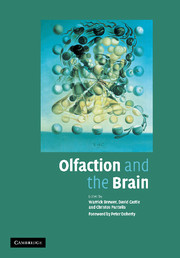Book contents
- Frontmatter
- Contents
- Foreword
- Preface
- List of Contributors
- Section I Neurology, Neurophysiology and Neuropsychology: Olfactory Clues to Brain Development and Disorder
- Section II Social Functioning: Role of Evolution, Genetics and Gender
- 8 Primate Olfaction: Anatomy and Evolution
- 9 Genetics and Family Influences on Olfaction: A Focus in Schizophrenia
- 10 Sex Differences and Olfactory Function
- 11 The Role of Pheromones and Chemistry: Lessons from Comparative Anatomy
- 12 The Impact of Olfaction on Human Social Functioning
- Section III Assessment and Disorders of Olfaction
- Index
- Plate section
- References
10 - Sex Differences and Olfactory Function
from Section II - Social Functioning: Role of Evolution, Genetics and Gender
Published online by Cambridge University Press: 17 August 2009
- Frontmatter
- Contents
- Foreword
- Preface
- List of Contributors
- Section I Neurology, Neurophysiology and Neuropsychology: Olfactory Clues to Brain Development and Disorder
- Section II Social Functioning: Role of Evolution, Genetics and Gender
- 8 Primate Olfaction: Anatomy and Evolution
- 9 Genetics and Family Influences on Olfaction: A Focus in Schizophrenia
- 10 Sex Differences and Olfactory Function
- 11 The Role of Pheromones and Chemistry: Lessons from Comparative Anatomy
- 12 The Impact of Olfaction on Human Social Functioning
- Section III Assessment and Disorders of Olfaction
- Index
- Plate section
- References
Summary
Introduction
In the early 1980s, in conjunction with the National Geographic Magazine, Wysocki and Gilbert set out on an ambitious quest. About 10.5 million ‘scratch and sniff’ surveys were distributed with the magazine in the hope of collecting population-based data on olfactory function. Over 1.4 million completed surveys were returned (Wysocki & Gilbert, 1989). Although limited in its scope, the data served to highlight a number of interesting points. Among those reported was the observation that women outperformed men on all measured aspects of olfactory ability. Moreover, the findings suggested that sex differences in olfactory perception were not uniform across different odorants. Although sex differences in olfactory sensitivity have been anecdotally known for centuries, the data derived from this investigation provided further insight into some of the diverse aspects of olfactory functioning that are differentiated between the two sexes. This monumental study served to spur on subsequent olfactory research, particularly in the realm of sex differences.
This chapter reviews the literature on sex differences in olfactory ability and describes the current state of knowledge on this subject. Moreover, some methodological shortcomings in published reports are outlined. Finally, some hypotheses are offered in order to explain the male/female difference in olfactory function.
Males and females differ in their ability to process odorants
Olfactory findings
Sex differences in olfactory function have been observed on virtually all olfactory measures examined.
Keywords
- Type
- Chapter
- Information
- Olfaction and the Brain , pp. 183 - 202Publisher: Cambridge University PressPrint publication year: 2006
References
- 5
- Cited by



